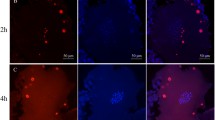Abstract
Most daphnid species adopt parthenogenesis and sexual reproduction differentially in response to varied environmental cues, resulting in the production of diploid progenies in both cases. Previous studies have reportedly suggested that daphnids produce their parthenogenetic eggs via apomixis; the nuclear division of mature oocytes should be an equational division similar to somatic mitosis. However, it seems premature to conclude that this has been unequivocally established in any daphnids. Therefore, the objective of our research was to precisely reveal the process and mechanism of parthenogenetic oogenesis and maintenance of diploidy in Daphnia pulex through histology, karyology, and immunohistochemistry. We found that, when a parthenogenetic egg entered the first meiosis, division was arrested in the early first anaphase. Then, two half-bivalents, which were dismembered from each bivalent, moved back to the equatorial plate and assembled to form a diploid equatorial plate. Finally, the sister chromatids were separated and moved to opposite poles in the same manner as the second meiotic division followed by the extrusion of one extremely small daughter cell (resembling a polar body). These results suggest that parthenogenetic D. pulex do not adopt typical apomixis. We hypothesize that D. pulex switches reproductive mode depending on whether the egg is fertilized or not.






Similar content being viewed by others
References
Bacci G, Cogneiti G, Vaccari AM (1961) Endomeiosis and sex determination in Daphnia pulex. Experientia 11:505–506
Beaton MJ, Hebert PDN (1994) Variation in chromosome numbers of Daphnia (Crustacea, Cladocera). Hereditas 120:275–279
Hebert PDN (1978) The population biology of Daphnia (Cruatacea, Daphnidae). Biol Rev 53:387–426
Hendzel MJ, Wei Y, Mancini MA, Hooser AV, Ranalli T, Brinkley BR, Bazett-Jones DP, Allis CD (1997) Mitosis-specific phosphorylation of histone H3 initiates primarily within pericentromeric heterochromatin during G2 and spreads in an ordered fashion coincident with mitotic chromosome condensation. Chromosoma 106:348–360
Itono M, Morishima K, Fujimoto T, Bando E, Yamaha E, Arai K (2006) Premeiotic endomitosis produces diploid eggs in the natural clone loach, Misgurnus anguilicautadus (Teleostei: Cobitidae). J Exp Zool 305A:513–523
Kühn A (1908) Die Entwicklung der Keimzellen in den parthenogenetischen Generationen der Cladoceren Daphnia pulex de Geer und Polyphemus pediculus de Geer. Arch Zellforsch 1:538–586
Lachowska D, Rożek M, Holecová M (2008) New data on the cytology of parthenogenetic weevils (Coleoptera, Curculionidae). Genetica 134:235–242
Lumer H (1937) Growth and maturation in the parthenogenetic eggs of Daphnia magna Strauss. Cytologia 8:1–14
Narbel M (1946) La cytologie de la parthénogenèse chez Apterona helix Sieb. (Lepid, Psychides). Rev Suisse Zool 53:625–681
Narbel-Hofstetter M (1950) La cytologie de la parthénogenèse chez Solinobia sp. (lichenella L.?) (Lépidoptères, Psychides). Chromosoma 4:56–90
Narbel-Hofstetter M (1963) Cytologie de la pseudogamie chez Luffia lapidella Goeze (Lepidoptera, Psychidae). Chromosoma 13:623–645
Narbel-Hofstetter M (1965) La variabilité cytologique dans la descendance des femelles de Luffia ferchaultella Steph. (Lepidoptera, Psychidae). Chromosoma 16:345–350
Ojima Y (1954) Some cytological observations on parthenogenesis in Daphnia pulex (de Geer). J Fac Sci Hokkaido Univ Ser VI, Zool 12:230–241
Ojima Y (1958) A cytological study on the development and maturation of the parthenogenetic and sexual eggs of Daphnia pulex (Crustacea, Cladocera). Kwansei Gakuin Univ Annu Stud 6:123–176
Otto SP, Barton NH (2001) Selection for recombination in small populations. Evolution 55:1921–1931
Peck JR (1994) A ruby in the rubbish: beneficial mutations, deleterious mutations and the evolution of sex. Genetics 137:597–606
Rożek M, Lachowska D, Milada H, Kajtoch Ł (2009) Karyology of parthenogenetic weevils (Coleoptera, Curculionidae): do meiotic prophase stages occur? Micron 40:881–885
Sakai C, Konno F, Nakano O, Iwai T, Yokota T, Lee J, Nishida-Umehara C, Kuroiwa A, Matsuda Y, Yamashita M (2007) Chromosome elimination in the interspecific hybrid medaka between Oryzias latipes and O. hubbsi. Chromosome Res 15:697–709
Sanderson AR (1952) Maturation and probable gynogenesis in the liver fluke, Fasciola hepatica L. Nature 172:110–112
Schurko AM, Logsdon JM Jr, Eads BD (2009) Meiosis genes in Daphnia pulex and the role of parthenogenesis in genome evolution. BMC Evol Biol 9:78
Stefani R (1960) L’Artemia salina parthenogenetica a Cagliari. Riv Biol 52:463–490
Sueoka N (1960) Mitotic replication of deoxyribonucleic acid in Chlamydomonas reinhardi. Proc Natl Acad Sci USA 46:83–91
Suomalainen E, Saura A, Lokki J (1987) Cytology and evolution in parthenogenesis. CRC Press, Boca Raton
Wei Y, Mizzen CA, Cook RG, Gorovsky MA, Allis CD (1998) Phosphorylation of histone H3 at serine 10 is correlated with chromosome condensation during mitosis and meiosis in Tetrahymena. Proc Natl Acad Sci USA 95:7480–7484
Welch DM, Meselson M (2000) Evidence for the evolution of bdelloid rotifers without sexual reproduction or genetic exchange. Science 288:1211–1215
Zaffagnini F, Sabelli B (1972) Karyologic observations on the maturation of the summer and winter eggs of Daphnia pulex and Daphnia middendorffiana. Chromosoma 36(2):193–203
Acknowledgements
We are grateful to Dr. Masakane Yamashita and his team, Faculty of Advanced Life Science, Hokkaido University, and Dr. Toru Miura and his team, Graduate School of Environmental Sciences, Hokkaido University, for helpful comments and suggestions on the study. We also thank the members of the Tochinai laboratory for their helpful advice and discussions. Chizue Hiruta was supported by a JSPS Research Fellowship for Young Scientists. This work was supported by a Grant-in-Aid for Exploratory Research, financed by the Ministry of Education, Culture, Sports, Science and Technology, Japan, to Shin Tochinai.
Author information
Authors and Affiliations
Corresponding author
Additional information
Responsible Editor: Yoichi Matsuda.
Rights and permissions
About this article
Cite this article
Hiruta, C., Nishida, C. & Tochinai, S. Abortive meiosis in the oogenesis of parthenogenetic Daphnia pulex . Chromosome Res 18, 833–840 (2010). https://doi.org/10.1007/s10577-010-9159-2
Received:
Revised:
Accepted:
Published:
Issue Date:
DOI: https://doi.org/10.1007/s10577-010-9159-2




